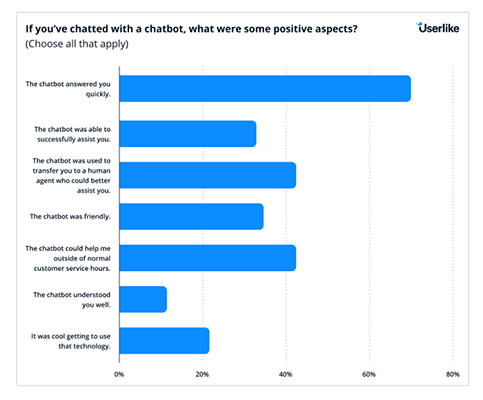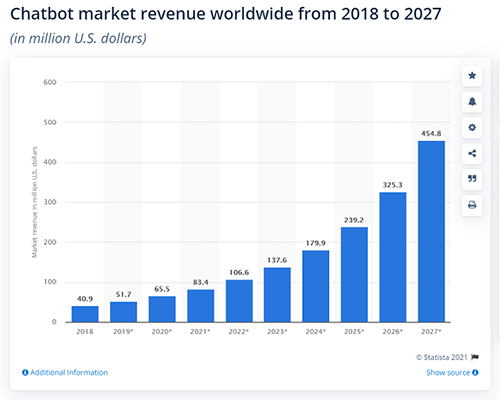Powered by natural language processing, chatbots are interactive software programs that emulate a human-like conversation. They can be found in apps, live chats, emails and SMS - making them versatile tools for businesses today.
And worry not! In the world of robots becoming our overlords, chatbots are probably the least harmless of the species. Or maybe that’s just what they want us to think…
This article discusses chatbot development basics, including what they are, which companies can benefit from them, and how to build customer-friendly chatbots to take your customer service to the next level.
What is a chatbot?
The idea of chatbots dates back to the 1950s. However, in recent years, their use has skyrocketed. This is because not only are they easy for anyone to access and install, but businesses have also found this virtual assistant to be an incredibly powerful tool. Chatbots leverage Artificial Intelligence, conversing with humans via natural language processing on various platforms such as apps, live chat, email, and SMS. With this technology at their fingertips, many companies have realised excellent results.
And, if you’re curious whether or not your grandpa was a chatbot–that’s outside the scope of this article.
What is Natural Language Processing?
Chatbot development requires natural language processing (NLP) to mimic human-to-human interaction. NLP is a tool that has revolutionised the way chatbots interact with people, making their conversations more natural. Natural language understanding (NLU) makes this possible by converting unstructured human speech into structured data which computers can comprehend.
The user sends a message to the bot, which is then processed through algorithms trained to detect and understand its meaning. In other words, NLU bridges communication between humans and machines in ways never before imagined.
Somehow, though, they still don’t get all our jokes. Hmm.
NLP enables chatbots to comprehend the context and intention of user input, making them an invaluable asset for businesses seeking to provide top-notch customer service. The demand for sophisticated technology is ever-increasing, so a chatbot isn't worth its weight in gold without NLP capabilities. Automation technologies like NLP-powered chatbots are vital tools to give your business a competitive edge in today's market.
Four Benefits of a Chatbot
More businesses are using chatbots to handle repetitive and early customer service requests. According to some data, 74% of users prefer chatbots when seeking answers to simple questions.
If you're considering installing or developing a chatbot, these could be some of the benefits you find:
1. They're always up–and ready to work
Chatbots don't need to eat, sleep, or scroll their TikTok feeds. By using a chatbot, your brand becomes not just accessible but also interactive at any time. Customers will be able to quickly and consistently obtain answers without you needing to stumble out of bed in the wee hours of the night - and no, this isn't an overhaul of human agents (not yet anyway). This responsiveness leads to better customer experiences, increased customer satisfaction, and better overall engagement.
Even better, every interaction is recorded and available to audit, helping you make the chatbot more reliable and improve over time for you. If only children were so easily trained.
2. They give the correct answers all the time
One of the biggest struggles in customer service is training and developing consistency. Our customers need the right answers to their questions, and with a chatbot, you'll dole out better advice and correct answers more often. They're never having a bad day (at least as far as we know), and they aren't distracted by their cat knocking over their coffee. They focus on one thing and one thing only–the customer.
Not only that, but these bots also provide in-depth records of customers' grievances which you can use to address them individually down the line. Consequently, a chatbot is key to obtaining insight into what consumers expect from your business! It may take a bit of time for the chatbot to learn and collect the data, but it offers incredible value once it does.
3. They help you scale up
One of the main drawbacks of having humans helping humans is that it's typically one-to-one support. If you are limited in the number of customer service representatives, then this can take a toll on your team and resources. It can also annoy customers as they listen to your terrible hold music or wait for "Bob" to enter the chatroom. This means you're now completing greater customer queries with less human intervention.
With a chatbot, "Bob" is always in the room–ready and waiting for the next person to join in (talk about great customer engagement). Reducing wait times alone is a great way to improve your customer service experiences big time.
4. They save you money
Chatbots can't replace your entire customer service team. And they probably shouldn't. 23% of consumers still say they prefer human or face-to-face interaction when dealing with more complicated problems. But, even replacing a part of your staff for a chunk of time per day is a money-saving business move.
While an investment is required upfront (maybe a significant one, depending on your needs), maintenance costs on chatbots are minimal. When compared to long-term labour costs, though, your CFO will most certainly approve.
How to Develop Your Own Chatbot
Whether you're creating one on your own or connecting with a partner, it's worth knowing how chatbots are developed. At the very least, this will allow you to take them apart if they ever decide to take over your business. Just kidding...maybe.
Choose your type of chatbot
No swiping left (or is it right?) is needed. You simply need to choose what type of chatbot you want to develop or deploy based on the services you want it to perform. Earlier, we mentioned the two main types; pattern-based and AI-based.
Most commonly, chatbots are used in customer service and sales. As a business, it is essential to recognise what type of chatbot would best suit your goals and meet customer expectations.
We know which one we’d choose, but hey, to each their own.
Where will the chatbot "live"
Obviously, we use the term live loosely. Basically, you want to decide where it will communicate with your customers. Remember that your chatbot is an extension of your business and brand, so ensuring you solidify the end user intent means a more robust chatbot. So, pick a channel best suited for its needs but doesn't negatively affect your business.
You'll want to consider whether you want your chatbot to be voice- or text-based (or both). How the communication channel integrates with your website (or social channels)? And how to market your chatbot so that users can find it - don't forget about ensuring it's optimised on mobile applications.
You can install a chatbot in a web widget on your website, through messaging apps like Facebook Messenger or Telegram, on cloud networks, in SMS, or through your CRM/email.
Of course, you have chatbot options through apps, too.
Pick a platform
Choosing the right technologies for automated human conversations is far from simple. But fortunately, after chatbots took off a while back, their development stack has become increasingly sophisticated and established along with AI and ML advancements for deep learning.
To start, any simple chatbot is powered by rules and automated processes set in motion through a conversational interface. As such, the world of bots has grown significantly over the last couple of years with specialised platforms and tools that enable interaction between humans and machines. This technology offers proven capabilities for those looking to create their own bot development projects.
The intertwined network of technologies and platforms that operate beneath the surface includes deployment channels, third-party chatbots, APIs for creating bots, and NLP tools, among other technology components.
Very nerdy stuff–which is why we like it!
Help it learn
While chatbots learn over time, some setup is necessary from the communication side of things.
The prime purpose of chatbot progress is customer service enhancement. To that end, ensuring the exchange between a human and a chatbot flows as effortlessly as possible is essential.
When creating your bot, ensure that questions are answered promptly with clear responses for conversations to remain fluid. Our advice is to gather a collection of common questions your customers have previously asked and develop it from there!
You'll also need to create a chatbot persona, even a name and tone of voice. Like any communication that comes from your business, it should be consistent and on-brand. Once these basics are set up, it will help you build your scripts and keep the same tone over time ensuring you have a conversational chatbot.
Basically, if you want to make your chatbot a moody teenager, go for it! We’re not sure it will help your business much, but it sure would be fun.
It's training montage time
Now that your chatbot's conversation scenarios are prepared and set, it's time to train the bot so you no longer have to guess what questions customers will ask. Rather than attempt to predict all inquiries coming into the chatbot, use the data available at hand to teach and improve your bot - you'll be glad for it.
For many companies, a chatbot that is connected to a website through an API and runs on pre-programmed scripts will be enough. But if you want your chatbot to mimic human behaviour and react in various complex situations, it needs specialised training. How does one train such bots? And how much training is necessary for optimal results?
To begin with, chatbots can be educated through conversational experiences your business has already received from call centre recordings and emails on social media platforms like Facebook Messenger. Other trusted chatbot training sources include Microsoft Research Social Media Conversation Corpus, Ubuntu Dialogue Corpus, Chinese Treebank, and Microsoft Azure LUIS.
Subsequently, a chatbot equipped with quality datasets can comprehend and answer inquiries through NLP.
Cue the soundtrack from Rocky and let’s run this baby through waist-deep snow.
Test your relationship
Before unleashing your AI baby into the world, you want to test it first. And test it thoroughly. There are multiple ways to ensure your bot is ready for launch before it goes live!
You can test it manually by simply launching into conversations with it. Assessing several workflow elements, such as intent matching, fallbacks, navigational paths, tone control, entity recognition, and user satisfaction, is critical. Subsequently, you should initiate usability tests and gain feedback from your users. Once everything meets your expectations, it's time to test with a small group of customers before going public. As usage increases, you can gradually expand until everyone can access the chatbot experience.
Unleash the beast
After you've done all the necessary steps, it's time to finally roll out and launch your chatbot! While ensuring customers will have a positive experience with your chatbot is an integral part of this process, there are plenty more opportunities for optimisation in the future. Allowing your chatbot to find its unique voice opens up infinite possibilities for further improvement.
To ensure the business' growth and success, it's essential to continuously develop your chatbot. Countless practices can help you enhance the quality of your bot, including change management (which is inextricable from setting up a chatbot,) source code control, as well as automation (including automated tests and deployments.)
Hail our chatbot overlords. You are now in command.
What parts of your business should chatbots focus on
Common industries and areas where chatbots make the most sense include:
Customer Service
Chatbots can handle customer requests, questions, and complaints. They can track orders and provide support. They are especially helpful when answering the same queries repeatedly.
Project Management and Personal Assistance
Chatbots can perform remedial tasks like scheduling appointments, setting reminders, turning voice notes into documents, and more. They may not be complex tasks, but they're repetitive tasks that can be covered so you have more time up your sleeve!
E-Commerce
Chatbots can assist users in purchasing and browsing products. It can also make recommendations based on the date they have about the person.
Lead Generation
Instead of "Always Be Closing," ABC now means "Always Be Chatbotting." Your chatbot can interact with potential customers, gather information, and reveal quality leads to your sales team through a variety of messaging platforms - talk about a streamlined sales process eh?
Healthcare
For healthcare companies, chatbots can be designed to provide medical information and assistance, even making recommendations or setting appointments for the user based on symptoms and their availability.
Financial Services
Banking, investment, fraud detection, accounting–there's no limit to how much chatbots can help with financial services.
Education and Training
If your products have a learning curve, a chatbot is a great place to provide consumer education and training.
Entertainment
Need to keep your audience entertained? Chatbots don't have to be all work and no play. You can create trivia games, and fun challenges, and make playlists for your users to interact with.
HR
HR managers can use chatbots to help with on or offboarding. They can collect feedback and perform surveys. They can even help with recruitment and employee engagement.
Travel
Help customers book flights, make hotel reservations, and provide restaurant recommendations. Chatbots are the new travel agent.
Chatbots transform how businesses communicate with their audiences and provide better customer service. By leveraging AI technology, these automated machines enable companies to offer a more personalised brand experience without needing human interference. As such, chatbots have become an essential part of any business's success.
With the ever-growing advancements of AI and ML, chatbots are becoming increasingly sophisticated information gatherers. Imagine the potential savings you could acquire when integrating them into your organisation's processes! They will provide an excellent customer service experience and reduce costs in sales operations - making it an investment that will pay off!
Are you ready to take your relationship with customers and prospects to the next level? Do you want a cost-effective way of connecting with them anytime, day or night, while addressing their challenges in real-time? Then it's time to develop a chatbot - the perfect solution for creating an engaged customer base.
Just make sure you’re nice to it–just in case.

